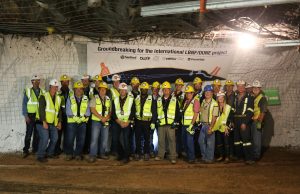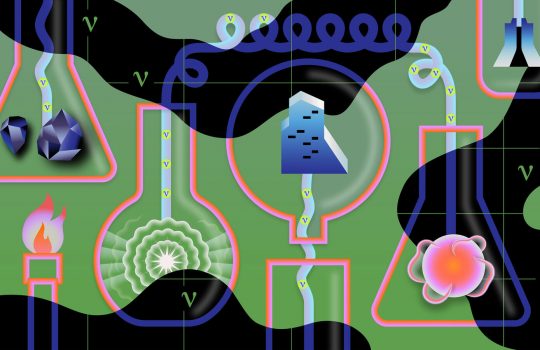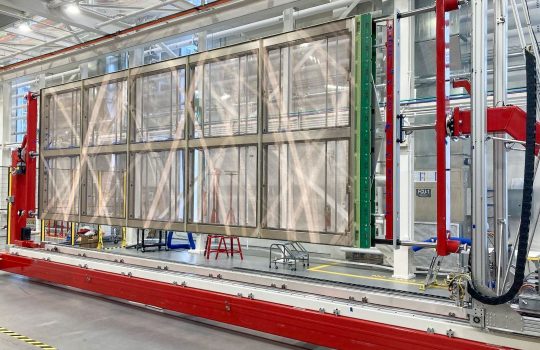
Attendees of a CM/GC kickoff meeting gathered at the future site of LBNF/DUNE to commemorate the beginning of a new partnership. Photo: Emily Collett
On July 21, a group of dignitaries broke ground on the Long-Baseline Neutrino Facility (LBNF) 4,850 feet underground in a former goldmine, making a small dent in the roughly 800,000 tons of rock that will ultimately be excavated for Fermilab’s flagship experiment.
But a groundbreaking ceremony doesn’t always mean you can get straight to digging.
Removing 800,000 tons of rock from a mile underground and assembling a massive particle detector in its place is a big job. Many months of careful design and preparatory construction work have to happen before the main excavation can even start at the future site of the Deep Underground Neutrino Experiment (DUNE) at Sanford Underground Research Facility in Lead, South Dakota.
On Aug. 9, a new team officially signed on to help prepare for the excavation and construction of DUNE. Fermi Research Alliance LLC, which operates Fermilab, awarded Kiewit/Alberici Joint Venture (KAJV) a contract to begin laying the groundwork for the excavation for LBNF, the facility that will support DUNE.
“Our team is excited and honored to serve as the construction manager/general contractor on a project like the Long-Baseline Neutrino Facility,” said KAJV Project Manager Scott Lundgren. “We look forward to working with Fermi Research Alliance to support this groundbreaking physics experiment.”
Under the contract, over the next 12 months, KAJV will assist in the final design and excavation planning for LBNF/DUNE.
“We’re all very excited about this partnership,” said Troy Lark, LBNF procurement manager. “It’s great to be working with two premier international contracting companies on this project.”
The four-story-high, 70,000-ton DUNE detector at LBNF will catch neutrinos — subatomic particles that rarely interact with matter — sent through the Earth’s mantle from Fermilab, 800 miles away. This international megascience experiment will work to unravel some of the mysteries surrounding neutrinos, possibly leading to a better understanding of how the universe began.
Building such an ambitious experiment has some unique challenges.
“It’s kind of like building a ship in a bottle,” said Chris Mossey, Fermilab’s deputy director for LBNF. “We’re using a narrow shaft to move all the excavated rock up, and then all the parts and pieces of very large cryostats and detectors down to the 4850 level, about a mile underground.”
KAJV will have two main tasks. The first is to help finalize design and excavation plans for LBNF. The second is to use the finalized designs to create what are known as bid packages: specific projects that KAJV or other contractors will work on.
These bid packages will include jobs such as building site infrastructure and ensuring the structural integrity of the building above the shaft through which everything will enter or exit the mine.
“Before you excavate about 800,000 tons of rock, there’s a lot of things you’ve got to do. You have to have a system to move the rock safely from where it’s excavated to the surface, then horizontally about 3,700 feet to the large open pit where it will be deposited,” Mossey said. “All that has to be built.”
Construction on pre-excavation projects — such as the conveyor system to move the rock — is expected to begin in 2018. The main excavation for LBNF/DUNE is planned to start in 2019.
“We’re really happy to get this contract awarded,” Mossey said. “It was a lot of work to get to this point — a lot by the project, the lab and the DOE team. Everybody worked to be able to get this big, complicated contract in place.”
Editor’s note: The amount of rock to be excavated for LBNF at the South Dakota site mentioned in this article was updated on May 2, 2019.



